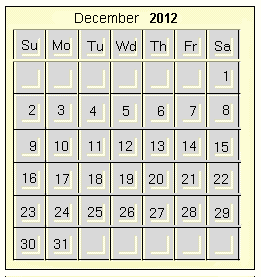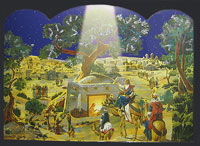German Christmas Traditions
German Christmas Traditions
November:
11th – Martinstag
![]() This is a day to pay tribute to Martin Luther and the reformation. It has taken on traditions similar to Halloween in the States. In Germany, it marks the beginning of the Holiday season. Begin making that list and checking it twice – be sure to check out smokers or nutcrackers at the Christkindlmarkts (Christ Child Markets).
This is a day to pay tribute to Martin Luther and the reformation. It has taken on traditions similar to Halloween in the States. In Germany, it marks the beginning of the Holiday season. Begin making that list and checking it twice – be sure to check out smokers or nutcrackers at the Christkindlmarkts (Christ Child Markets).
![]() Some families choose to decorate a Christmas tree this day, other families incorporate tree decorations as part of Advent Sundays or unveil a decorated tree on Christmas Eve. As you are decorating your tree, have Christmas incense wafting through a holiday German smoker.
Some families choose to decorate a Christmas tree this day, other families incorporate tree decorations as part of Advent Sundays or unveil a decorated tree on Christmas Eve. As you are decorating your tree, have Christmas incense wafting through a holiday German smoker.
December:

2nd – First Sunday of Advent
![]() Bring out the Advent wreath and candles. Light the first of four candles, the candle of Expectation.
Bring out the Advent wreath and candles. Light the first of four candles, the candle of Expectation.
![]() Introduce your children to the season of Advent and help them anticipate Christmas with an Advent calendar. These have windows with images & different meanings leading up to Christmas festivities and make it easy to share the holiday moments.
Introduce your children to the season of Advent and help them anticipate Christmas with an Advent calendar. These have windows with images & different meanings leading up to Christmas festivities and make it easy to share the holiday moments.
4th – Barbarazweig – Or St. Barbara’s Day
![]() German Tradtion of placing a twig of a cherry or apple tree into a bowl of water; it is good luck if it blossoms by Christmas day. Other regions in Germany will try and sprout wheat instead of branches, but the theme of growth following winter solstice is consistent. If you are unable to get a live branch from one of these trees, consider putting an apple or another fruity incense cone into a German smoker and enjoy watching the scent “blossom” and waft.
German Tradtion of placing a twig of a cherry or apple tree into a bowl of water; it is good luck if it blossoms by Christmas day. Other regions in Germany will try and sprout wheat instead of branches, but the theme of growth following winter solstice is consistent. If you are unable to get a live branch from one of these trees, consider putting an apple or another fruity incense cone into a German smoker and enjoy watching the scent “blossom” and waft.
5th – Nikolausabend – Or Nickolas Eve (celebrated by non-protestant regions in Germany)
![]() The night before Saint Nickolas’ Feast day, small gifts are given, especially to children. A man dressed as Saint Nick gives the gifts. These are opened, sometimes then, but usually the next day during the “feast”.
The night before Saint Nickolas’ Feast day, small gifts are given, especially to children. A man dressed as Saint Nick gives the gifts. These are opened, sometimes then, but usually the next day during the “feast”.
![]() Explain the story of Saint Nicholas to your children with a German smoker or nutcracker in the character of the Bishop of Myra.
Explain the story of Saint Nicholas to your children with a German smoker or nutcracker in the character of the Bishop of Myra.
9th – Second Sunday of Advent

![]() Light the second candle of Advent. This candle represents the trip Mary, mother to Jesus, the Christ Child, to Bethlehem where she gave birth to him. It also represents the peace and love that Christ brought to the earth. Be sure to tell your family members that you love them today. Continue to open windows of your Advent Calendar for each day of Advent.
Light the second candle of Advent. This candle represents the trip Mary, mother to Jesus, the Christ Child, to Bethlehem where she gave birth to him. It also represents the peace and love that Christ brought to the earth. Be sure to tell your family members that you love them today. Continue to open windows of your Advent Calendar for each day of Advent.
16th – Third Sunday of Advent
![]() Light the third candle in your Advent wreath. This candle, usually pink, symbolizes the choir of angels, which heralded the birth of the Christ Child and the Shepherds who went to visit him. It ultimately symbolizes the joy of the season
Light the third candle in your Advent wreath. This candle, usually pink, symbolizes the choir of angels, which heralded the birth of the Christ Child and the Shepherds who went to visit him. It ultimately symbolizes the joy of the season
![]() Consider making one of the following traditional German Christmas foods to continue celebrating this holiday season: Christstollen (or fruit cake), Gluhwein (or spiced wine) & Lebkuchen (or ginger bread). Building and decorating a gingerbread home with your children would be a fun way to spend the day.
Consider making one of the following traditional German Christmas foods to continue celebrating this holiday season: Christstollen (or fruit cake), Gluhwein (or spiced wine) & Lebkuchen (or ginger bread). Building and decorating a gingerbread home with your children would be a fun way to spend the day.
![]() Scent your home with the smell of fresh-baked Lebukuchen with ginger scented incense.
Scent your home with the smell of fresh-baked Lebukuchen with ginger scented incense.
![]() Many German families, even non-religious ones, decorate their tables during the Holiday season with scenes of the nativity or the holidays by grouping figurines with the various expected characters, like Mary, Joseph, Christ Child, Angels, Shepherd, etc. But they also include many unexpected figurines into their table displays. In the Erzgebirge region it is not unusual to find a miner or woodsmen amongst the holiday figurines. Other families incorporate the nativity by having a German Christmas candle carousel or pyramid on display.
Many German families, even non-religious ones, decorate their tables during the Holiday season with scenes of the nativity or the holidays by grouping figurines with the various expected characters, like Mary, Joseph, Christ Child, Angels, Shepherd, etc. But they also include many unexpected figurines into their table displays. In the Erzgebirge region it is not unusual to find a miner or woodsmen amongst the holiday figurines. Other families incorporate the nativity by having a German Christmas candle carousel or pyramid on display.
23th – Fourth & Final Sunday of Advent
![]() Light the fourth candle in the Advent wreath. On the 24th Christmas Eve, some families will light the central candle as well, others wait until the morning. The fourth candle symbolizes the actual birth of the Christ Child and the central candle, usually the white one, represents Christ or joy fulfilled.
Light the fourth candle in the Advent wreath. On the 24th Christmas Eve, some families will light the central candle as well, others wait until the morning. The fourth candle symbolizes the actual birth of the Christ Child and the central candle, usually the white one, represents Christ or joy fulfilled.
![]() In some households gifts are given now (as if from the Christkindl or Christ Child – not Santa), others choose to wait until Christmas morning. Many also attend mass or a Christmas Eve service at their churches.
In some households gifts are given now (as if from the Christkindl or Christ Child – not Santa), others choose to wait until Christmas morning. Many also attend mass or a Christmas Eve service at their churches.
![]() Children will often leave their shoes near the chimney or under the tree Christmas Eve (similar to the American tradition of stockings pinned to the fireplace mantle) for small gifts and sweets to be placed in their shoes while they sleep.
Children will often leave their shoes near the chimney or under the tree Christmas Eve (similar to the American tradition of stockings pinned to the fireplace mantle) for small gifts and sweets to be placed in their shoes while they sleep.
25th – Christmas Day
![]() This would be a good time to wrap up the Advent calendar if you have been using one to share anticipation for Christmas Day with your children or the young at heart. All of the windows should be open.
This would be a good time to wrap up the Advent calendar if you have been using one to share anticipation for Christmas Day with your children or the young at heart. All of the windows should be open.
![]() Almost all shops are closed today as families spend time together eating a traditional German Christmas meal of fish or goose as part of their festivities.
Almost all shops are closed today as families spend time together eating a traditional German Christmas meal of fish or goose as part of their festivities.
![]() If the family is going to open gifts today, they are called in by their parents with the ringing of a bell.
If the family is going to open gifts today, they are called in by their parents with the ringing of a bell.
26th – Boxing Day
![]() Christmas day is set aside traditionally for family. The day after Christmas is the day set aside to go and bring gifts to friends. It is called “Boxing Day” in reference to gifting of boxes to the needy.
Christmas day is set aside traditionally for family. The day after Christmas is the day set aside to go and bring gifts to friends. It is called “Boxing Day” in reference to gifting of boxes to the needy.
Be sure to wish your friends and family, "Fröhliche Weihnachten!" or a Merry Christmas!
